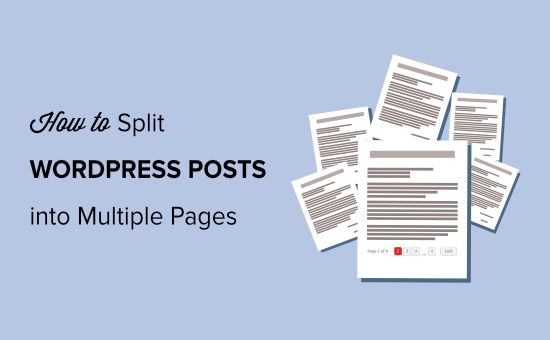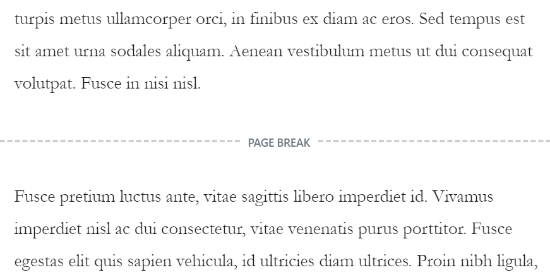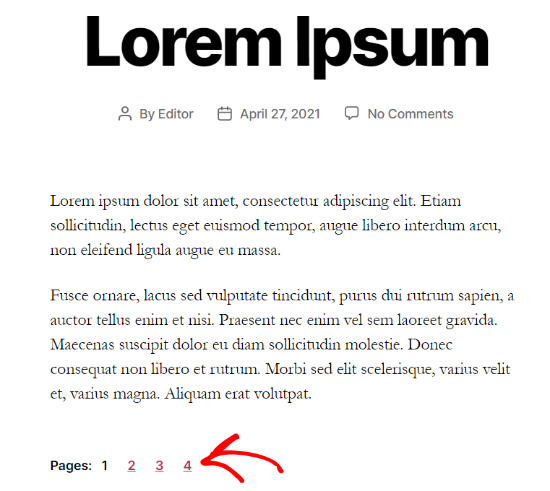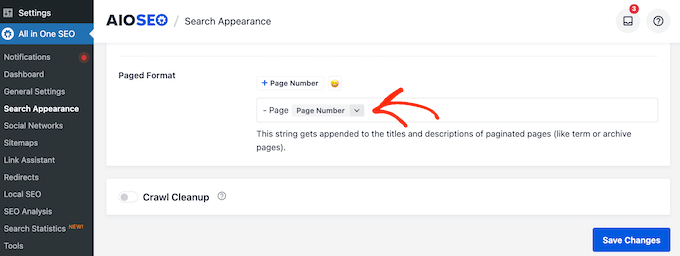Le lunghe pubblicazioni su WordPress possono essere difficili da leggere. Come condividere contenuti dettagliati senza perdere l’interesse dei lettori?
La risposta è la paginazione dei post, che significa dividere una lunga pubblicazione in diverse pagine più brevi. Abbiamo utilizzato questo metodo per suddividere grandi guide e lunghi tutorial in alcuni dei nostri progetti di blog. Ogni volta abbiamo notato che i lettori si sono impegnati di più con i contenuti.
In questa guida vi mostreremo come dividere le vostre pubblicazioni su WordPress in più pagine. Verranno coperti metodi semplici, con e senza plugin.

Perché dividere i post di WordPress in più pagine?
Se i post del blog WordPress o le guide sono lunghi, l’impostazione della paginazione di WordPress può migliorare la leggibilità dei contenuti.
È utile suddividere un lungo post in diverse sezioni e dividerle in più pagine. In questo modo, i visitatori possono digerire facilmente i contenuti e leggere le sezioni di loro interesse.
Un altro vantaggio della suddivisione delle pagine pubbliche di WordPress è che può aumentare l’engagement degli utenti. Quando gli utenti navigano tra i contenuti impaginati, ogni pagina che visualizzano contribuisce ad aumentare le paginazioni, il che può avere un impatto positivo sulle metriche complessive del sito web.
Detto questo, vediamo come suddividere i post di WordPress in più pagine. Vediamo come suddividere i post di WordPress in più pagine senza un plugin e utilizzando un plugin di WordPress:
- Metodo 1. Dividere un post di WordPress in più pagine senza plugin
- Metodo 2. Dividere più post di WordPress in più pagine utilizzando un plugin
Metodo 1: Dividere un singolo post in più pagine senza un plugin
Il modo più semplice per impostare la paginazione delle pagine è utilizzare il blocco “Interruzione di pagina” nell’editor a blocchi di WordPress. Non è necessario un plugin per WordPress per suddividere gli articoli in più pagine.
Per prima cosa, è necessario modificare o aggiungere un nuovo post sul sito WordPress utilizzando l’editor di blocchi Gutenberg.
Successivamente, fare clic sul pulsante ‘+’ nel punto in cui si desidera dividere il contenuto e aggiungere un blocco Interruzione di pagina.

A questo punto si dovrebbe vedere una linea di interruzione di pagina nel contenuto per indicare dove apparirà la paginazione.
Avrà un aspetto simile a questo.

Se si utilizza il vecchio editor classico, si può usare il tag <!--nextpage--> per dividere il contenuto.
Quando si scrive un post di un blog, basta andare nella vista dell’editor ‘Testo’ per inserire il tag in cui si desidera dividere il lungo articolo.

È anche possibile utilizzare i tasti Alt + Shift + P della tastiera per inserire interruzioni di pagina. A tale scopo, passare alla vista ‘Visuale’ e premere i tasti di scelta rapida nel punto in cui si desidera aggiungere un’interruzione di pagina.
Dopodiché, è possibile visualizzare l’anteprima e pubblicare il post del blog. Ora si vedrà la paginazione del post in fondo al suo contenuto.

Metodo 2: Dividere più post di WordPress in più pagine utilizzando un plugin
Un altro modo per suddividere i contenuti lunghi in varie pagine è utilizzare un plugin di paginazione. Il vantaggio di questo metodo è che impagina automaticamente i post quando soddisfano determinati criteri.
Per questo metodo, utilizzeremo il plugin gratuito Automatically Paginate Posts, in quanto è facile da usare e funziona con qualsiasi tema di WordPress.
Nota: si può notare che questo plugin non è stato testato con le ultime versioni di WordPress. Tuttavia, lo abbiamo provato noi stessi e funziona meglio di tutti i plugin che abbiamo controllato.
Per saperne di più sull’opportunità di utilizzare plugin WordPress non testati, consultate il nostro articolo. Se trovate un plugin che funziona meglio di quello che vi abbiamo proposto, fatecelo sapere nei commenti qui sotto!
Per prima cosa, è necessario installare e attivare il plugin Automatically Paginate Posts sul vostro sito web WordPress. Per maggiori dettagli, potete consultare il nostro tutorial su come installare un plugin di WordPress.
Una volta che il plugin è attivo sul vostro sito, andate su Impostazioni ” Lettura e scorrete fino alla sezione “Paginazione automatica dei post”.
È possibile selezionare i tipi di post da suddividere in pagine diverse. Successivamente, è possibile scegliere se suddividere i post in base al numero totale di pagine o alle parole approssimative per pagina.

Quindi, fare clic sul pulsante “Salva modifiche” per memorizzare le impostazioni.
Il plugin suddivide automaticamente i contenuti in base alle impostazioni. Tuttavia, è possibile aggiungere manualmente le interruzioni di pagina ai contenuti utilizzando il plugin.
Suggerimento bonus: Utilizzare AIOSEO per ottimizzare la paginazione dei post
La paginazione dei post lunghi può sicuramente migliorare l’esperienza dell’utente. Detto questo, è importante configurare correttamente il post in modo che non influisca negativamente sulla SEO (ottimizzazione dei motori di ricerca) del sito.
Se un post del blog è distribuito su più pagine a causa della paginazione, Googlebot potrebbe finire per indicizzare più copie dello stesso contenuto. Questo può portare a problemi di contenuti duplicati.
Per fortuna, potete evitarlo utilizzando il plugin All in One SEO (AIOSEO). Questo plugin SEO per WordPress consente di rendere il vostro sito SEO-friendly in modo semplice, anche se non avete alcuna competenza tecnica.
AIOSEO inserisce automaticamente un numero di pagina nel titolo SEO dei contenuti paginati. In questo modo, i motori di ricerca possono capire che il post è stato distribuito su più pagine e non è un duplicato di un altro post.

Inoltre, AIOSEO rimuoverà questi numeri di pagina dagli URL delle pagine dei post. In questo modo i motori di ricerca sapranno qual è la pagina principale del blog che dovrebbero classificare per le parole chiave pertinenti e che gli utenti dovrebbero vedere per prima.
Ciò avviene attivando automaticamente l’impostazione “No Pagination for Canonical URLs”.

Per ulteriori informazioni su AIOSEO, consultare il nostro articolo su come configurare AIOSEO per WordPress.
Altri suggerimenti per gestire i contenuti lunghi in WordPress
La suddivisione delle pubblicazioni in pagine è solo uno dei modi per gestire i contenuti lunghi. Ecco altre tecniche che abbiamo trovato utili:
- Itooltip sono ottimi per aggiungere dettagli extra senza ingombrare il contenuto principale. Appaiono quando i lettori passano del mouse su alcune parole.
- Mantenete l’engagement dei lettori mostrando loro contenuti correlati proprio nel mezzo delle vostre pubblicazioni.
- Se avete un argomento molto vasto da coprire, considerate la possibilità di creare una serie di pubblicazioni invece di scrivere un lungo blog su chi siamo. In questo modo i lettori potranno seguirli facilmente.
- Il titolo della pubblicazione è di solito un’unica head, ma si può spezzare in una nuova riga se è troppo lungo per renderlo più leggibile.
Speriamo che questo articolo vi abbia aiutato a capire come dividere i post di WordPress in più pagine. Potreste anche voler consultare la nostra guida su come add-on il pulsante load more nei post di WordPress e la nostra scelta dei migliori plugin per i post correlati in WordPress.
Se questo articolo vi è piaciuto, iscrivetevi al nostro canale YouTube per le esercitazioni video su WordPress. Potete trovarci anche su Twitter e Facebook.





maik
How to invert the pagination, I want create a page and spliting in multiples pages to show the recent posts? : This mode: 3, 2, 1. and no Pages 1, 2, 3.
semmy
Hi thank you very much for your tutorial. It’s work, oh ya I want to ask something about adsense, how we can add adsense below multiple pages, can you create a tutorial for that one? many thanks
Edwin
Thanks for the tip, I’ve recently tried this, and the pagination shows up correctly, but when clicking the links (2,3,4,etc.), i get a page not found error. Do you have any idea what would cause that?
Ricardo Cury
You might want to check you Permanent Links Structure.
Edmond
Hi,
Can you please do a tutorial on how to create the “view all” function too, as it’s really very useful. I’ve seen a similar thing here: http://list25.com/25-most-expensive-private-jets-ever-made/ (http://list25.com/25-most-expensive-private-jets-ever-made/?view=all)
Thanks!
Edmond
Hi,
Really love the feature of splitting pages. I also see that you have the “View All” option on list25.com. How can I add that same feature to my website? I’d really love to see a tutorial for this too.
João Paulo Porto
i have the same question
João Paulo Porto
If for some reason, pagination is not showing up after you have pasted the next page tags, then you would need to add the following code in your single.php loop.
Which code are you talking about? I really need this code.
Lester
Olá João Paulo,
Have you noticed how to manage pagination on wordpress long posts? This thread is not really helpful. I´m using wp 2.2.2 and I´m looking for splitting long posts in 1,2,3,4…view all pages too !
WPBeginner Staff
See how to add numeric pagination to WordPress themes.
Josh
how to create pagination like wpbeginner.com ? thanks
Ameet Mehta
Hi, where is the code that is supposed to be pasted, seems like something got pulled out of the article?
kankan929
YES!!!! I saw that Kim Komando did this and wondered HOW. So glad I stumbled across this blog. And now I’m a FAN! Thanks for sharing this information.
WPBeginner Staff
Yes it does if you have long articles with lots of images. You split the page, which reduces the page load time. Increased page views and lower bounce rates are an added bonus.
MikeMeisner
Great little tip – do you think this helps with SEO and rankings by lowering the bounce rate and increasing pageviews? I notice a few buzzfeed types sites using this method..
Donna
what is a single.php loop? where do I place that code? the pagination is not working for me.
Jamie_Mannion
I paste the code in the text view, switch to visual and it’s there as I pasted it, switch back to text and it shows as <!––nextpage––> the problem was the “pasting”. I manually typed it and I was away. Thanks guys!
Patrick
Hi Syed,
Thanks for the tip. I’m wondering, though, the page numbers come up at the top of the post, rather than following it. How can I change that, or at least duplicate it?
Bonnie Martin
Awesome tip. I didn’t know about that before this.
James
Hi Syed,
I have just implemented a facebook like button at the top of every post page. and split a few long blog posts up into multiple pages.
The problem is if someone is on page 3 of the article for example, and clicks the share button, the url of that page gets shared – nameofsite.com/nameofpost/3.
How can I ensure that just the first page/main page of the post gets shared with all my paginated posts?
Thank you,
James
Boby Kurniawan
You know , i always love this website. I found many wordpress trick here. Thank you .
I have a question, how i put the “split” at top of article after the title ? is it posible ? thanks .
Sorry for bad english
Basavaraj Tonagatti
Hi,
I have few posts which have plenty of comments like around 800. Because of this these particular posts load slowly. So how if I paginate them by going to Discussion Settings–>Other Comments Settings–>Break Comments into pages of 100 each?
Lops
Hey! This worked incredibly fine, replacing the — manually did fix it when it didn’t work and now it’s awesome.
I’m just having trouble because I’m working on very lenghty articles and I would like a table of contents at the top of the page too, not just at the bottom of the page. Can’t we have the [1] [2] [3] etc. links at the top of the page too?
ashutosh joshi
I need to show “next page” and “previous page” in place of pagination. What should I do for that?
David
Hi Syed,
Thanks for the tip. I have a question to be sure.
This will create duplicate content, as http://domain.com/postname, http://domain.com/postname/1/, http://domain.com/postname/2/.
Would it be correct to add, for example using the SEO Yoast plugin, the canonical url at http://domain.com/postname?
Would this reduce any problem for duplicate content in the major search engines?
Thank you.
WPBeginner Support
WordPress SEO will make the actual post URL the canonical URL.
Admin
David
You mean, without writing anything in the canonical url space? Does it do it automatically so that I don’t have to specify it?
Thanks
David
Hi,
After a bit of investigation, I’ve found out that if you don’t write anything on WPSEO canonical space, wordpress will take care of it and create a different canonical url for each page, with duplicate content. It doesn’t play nice with all the themes probably, so it’s better to check.
So if you write the right canonical url (usually the main page) in the WPSEO space, it will index the first and not the others and will relate all the others pages /2, /3.. to the first. And this is one solution.
But if you want to index all the content of the other pages, because maybe they are worth it and long pages as well, then you can write “next” on the canonical space, and all the pages will be linked as rel=”next” and rel=”prev”.
Edward Chung
Thanks for introducing the technique. What I concern most is the SEO implication, would the author please suggest whether the SEO would be hurt or not? Thanks!
WPBeginner Support
No, if any thing it will probably improve SEO. Your page load time will increase, users will not have to scroll a lot this means user experience will improve. A Better user experience is also one of the factors considered by search engines when ranking a site. Using post pagination correctly will benefit your site’s SEO. However, using it just to increase page and ad impressions will probably backfire.
Admin
Oscar Gonzalez
Do you know of a plugin or a hack that would allow me to give the user an option next to the pagination links when using multiple pages?
Like page 1, 2, 3,
OR below that show a link that reads:
view as one page
I think some big sites do that with slideshow posts, Any suggestions on providing that to the user?
Thanks!
Crear Cuenta Outlook
thank for the info i will use this in my site, but how i can get pagination on the home page?
WPBeginner Support
Here is how to add numeric pagination in your WordPress theme.
Admin
Crear Cuenta Outlook
thanks
Kalyan
I being having a travel blog (wordpress platform), thought of splitting the article. But, by using the method you said above, the url of the page is changing for each split. Is there any plugin or any thing which can split the article with the url remaining the same. Please let me know if you know any such plugin.
Thanking You
WPBeginner Support
You can take a look at toggle effect to show/hide content in a post.
Admin
Diana
The pagination shows up, but whenever I click to an actual page, it still shows me the entire article.
Laurence
I leave blogs split over many pages they’re really annoying. I can’t scan the page so it takes too long. Especially the blogs that have. “Top 10 whatever” with each one on its own page. Just put them on one page for me why on earth make it harder for me to get content. I don’t think split pages decrease the average bounce rate across all pages.
Aslam
I saw a lot of people complaining that the code tags aren’t working and the reason is that if you copy paste the on this page it will not work, maybe some character issue with the “–” characters on this page.
Just manually type the “–” wherever you are using the tag and it will work.
Manual typing worked for me.
Kristof Bernaert
Exactly the problem I faced too. Thanks for posting that!
James Roland
Thanks! That was my problem as well. Typing it manually did the trick
Aristides Guerra
I almost gave up upon manually replacing the underscores ( _ ) from the code given above but then I also replaced the two dashes( — ) from
and it works! thank you all!
Seema
Thanks Aslam, you solved my problem.
Tor André Sandum
THANKS! Manually writing worked, copy/paste did not!
John
@Syed Balkhi I have to agree with AleC that original post split looks very boring. Please write a detailed tutorial for a newbies like us, on how to give it a beautiful and stylish looks with eye catching colors, just like you are using at list25. Thanks and i hope you will share it soon with your regular reader. I will wait
WPBeginner Support
We will try to show how to style WordPress post pagination links. Meanwhile, do check the Codex page for styling page links. Also feel free to study and use list25 stylesheet and modify it to match your theme.
Admin
Haseeb Ahmad Ayazi
Whenever I google any wordpress query, wpbegginner come first, very hard @Syed Balkhi
Christina
Thank you for your answer. That makes a lot of sense. One more question: Do you know a post pagination plugin with works in combination with a post index? I have some long posts on my website which have their own little post index. If I now implement a post pagination, I would like to keep the post index which means that if a user klicks on a post index element, he should then jump to a separate post sub page.
Christina
Does post pagination have any impact on site performance/loading time? I was told not to implement it because it slows down the website. Is this true?
WPBeginner Support
The purpose of adding pagination is to break down lengthy posts into pages. It should in fact speed up the page load time.
Admin
Lauren Wilson
Is it possible to have two posts pages? i.e news and jobs?
Sri Ganesh.M
Not Working, After which line in single.php we should add it ! i added in HTML view only
Kenshin
Does this work on wordpress.com blogs also?
Editorial Staff
Yes it should.
Admin
rami
YUP!!!It Worked.Thanks for your great contribution.
Pranjal
I thought, it wasn’t working on mine, lately I read it somewhere else, I need to put the given tag into html view, and finally it worked. Please mention in your article as well, as I know many noobs like me are out there
rami
I agree with Pranjal. Please mention where the tag to be place.
Editorial Staff
Updated the article.
Admin
Jose Robles
Tried it but my links for the other pages shows up at the way bottom left of my website rather than appearing even before the comments. Any ideas why that would be? Website is ReignMediaLA.com and the theme is Press Grid.
Editorial Staff
Sounds like an issue with your theme’s styling.
Admin
Eva
Never mind.. Of course it worked AFTER I’d tried for half an hour and finally decided to complaint.
Of course it worked AFTER I’d tried for half an hour and finally decided to complaint.
Eva
I’ve tried to use the code but all I get is the code text in my post :/ I’ve only used the HTML window to place the code and yet – there it is – on my post as text, not as next page.
What can I do?
AleC
Hi guys,
Don’t ask me how, but I manage to do this in my site and it works like a charm!
BUT I don’t know how to give the numbers a style. I’m looking for something like you did in here, big numbers with a huge box of color. Can you help me with this? May be if you give me the line of code you used.
Sorry if I sound silly, but I don’t really know code.
Please!
Editorial Staff
There is no code involved. You have to know CSS formatting.
Admin
Gidon
Great! And so easy! Thank you!
Tom
It wont work even if you follow these instructions, the correct code is ‘ not as you said (you had only single dashes) – also you should tell people that it needs to be entered in html view on visual.
Editorial Staff
Ah darn the auto-formatting. It was showing correctly in the backend, but then on the front-end it turned our two dashes into one big dash. Fixed that. Thanks for pointing it out.
Admin
Colin
Darnit, tried to get this to work on my site but failed
Was hoping as it was a premium theme it would work out of the box but sadly not.
As an SEO I can say there should be no problem with this SEO-wise. If anything having an extra couple of pages won’t hurt.
Raja
Hi,
I tried what you’ve said, but ot still doesnt work on my theme. i’m using goodnews theme from themeforest
Editorial Staff
Hey Raja,
This is a standard WordPress feature. If it doesn’t work with your theme, then you should contact the theme author and ask them to add the support for it.
Admin
wpbeginner
You know Stephen, I would have agreed with you on almost all of those cases a few months ago. I still do agree with you that this works only in very specific cases. However, after seeing the numbers on our new site, my perspective has changed a little bit. First of all, if your article is good enough, then the user will go to the next page. In terms of SEO, definitely not true. If you have sufficient amount of content on each page, then it will not hurt you in SEO for a single bit. Forbes, NYTimes, and countless other big name sites do this and rank perfectly fine for SEO. If your content is good, then it will be shared, it will be linked, and it will be read by your users.
FuturePocket
@wpbeginner I agree, I am planning to write a three part article (which is going to be somewhere in the area of 5000+ words) and I really don’t want to fit it all into one page. I am contemplating whether to stick with pagination or split it into multiple articles — but I will have to do a little bit more keyword research before I decide. If the ideas I intend to discuss are in a wide variety of keywords, than I’ll probably split it, otherwise this pagination method will work out quite nicely! Thanks for the share.
YuriyNikolaev
Thanks God for give us WPBeginner!
Stephen Cronin
Thanks for telling us how to do this, but I hope not too many people actually implement it and split their posts.
That’s a relic of the days when people artificially increased their page views to increase advertising revenue, but thankfully most people these days recognise that it leads to a poor user experience. I personally leave sites as soon as I see paged articles (unless I really *have* to read it).
There’s also the SEO implications – you’re probably going to rank better with one long article than you would with 5 smaller pages.
And I could go on, but I’ll stop there. It’s not a good idea in 99.9% of cases.